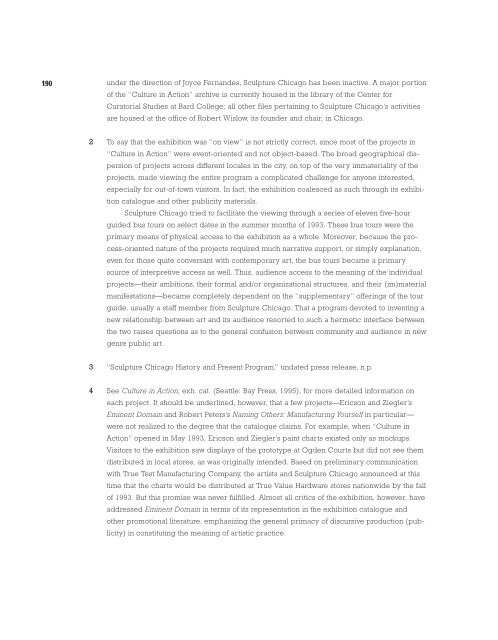ONE PLACE AFTER ANOTHER - Monoskop
ONE PLACE AFTER ANOTHER - Monoskop
ONE PLACE AFTER ANOTHER - Monoskop
Create successful ePaper yourself
Turn your PDF publications into a flip-book with our unique Google optimized e-Paper software.
190<br />
under the direction of Joyce Fernandes, Sculpture Chicago has been inactive. A major portion<br />
of the “Culture in Action” archive is currently housed in the library of the Center for<br />
Curatorial Studies at Bard College; all other files pertaining to Sculpture Chicago’s activities<br />
are housed at the office of Robert Wislow, its founder and chair, in Chicago.<br />
2 To say that the exhibition was “on view” is not strictly correct, since most of the projects in<br />
“Culture in Action” were event-oriented and not object-based. The broad geographical dis-<br />
persion of projects across different locales in the city, on top of the very immateriality of the<br />
projects, made viewing the entire program a complicated challenge for anyone interested,<br />
especially for out-of-town visitors. In fact, the exhibition coalesced as such through its exhibition<br />
catalogue and other publicity materials.<br />
Sculpture Chicago tried to facilitate the viewing through a series of eleven five-hour<br />
guided bus tours on select dates in the summer months of 1993. These bus tours were the<br />
primary means of physical access to the exhibition as a whole. Moreover, because the process-oriented<br />
nature of the projects required much narrative support, or simply explanation,<br />
even for those quite conversant with contemporary art, the bus tours became a primary<br />
source of interpretive access as well. Thus, audience access to the meaning of the individual<br />
projects—their ambitions, their formal and/or organizational structures, and their (im)material<br />
manifestations—became completely dependent on the “supplementary” offerings of the tour<br />
guide, usually a staff member from Sculpture Chicago. That a program devoted to inventing a<br />
new relationship between art and its audience resorted to such a hermetic interface between<br />
the two raises questions as to the general confusion between community and audience in new<br />
genre public art.<br />
3 “Sculpture Chicago History and Present Program,” undated press release, n.p.<br />
4 See Culture in Action, exh. cat. (Seattle: Bay Press, 1995), for more detailed information on<br />
each project. It should be underlined, however, that a few projects—Ericson and Ziegler’s<br />
Eminent Domain and Robert Peters’s Naming Others: Manufacturing Yourself in particular—<br />
were not realized to the degree that the catalogue claims. For example, when “Culture in<br />
Action” opened in May 1993, Ericson and Ziegler’s paint charts existed only as mockups.<br />
Visitors to the exhibition saw displays of the prototype at Ogden Courts but did not see them<br />
distributed in local stores, as was originally intended. Based on preliminary communication<br />
with True Test Manufacturing Company, the artists and Sculpture Chicago announced at this<br />
time that the charts would be distributed at True Value Hardware stores nationwide by the fall<br />
of 1993. But this promise was never fulfilled. Almost all critics of the exhibition, however, have<br />
addressed Eminent Domain in terms of its representation in the exhibition catalogue and<br />
other promotional literature, emphasizing the general primacy of discursive production (publicity)<br />
in constituting the meaning of artistic practice.

















